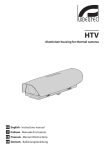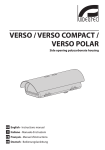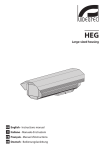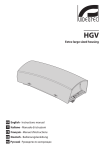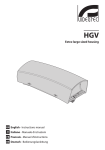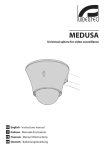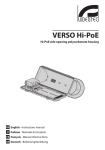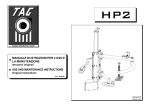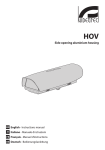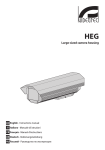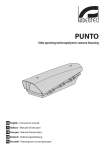Download Videotec HEK30D0Y000B camera housing
Transcript
HEK Aluminium and thermoplastic housing EN English - Instructions manual IT Italiano - Manuale di istruzioni FR Francais - Manuel d'instructions DE Deutsch - Bedienungslanleitung HEK Aluminium and thermoplastic housing EN English - Instructions manual Contents ENGLISH 1.1 Typographical conventions................................................................................................................................. 5 2 Notes on copyright and information on trademarks................................................. 5 3 Safety rules.................................................................................................................... 5 4 Identification................................................................................................................. 6 4.1 Product description and type designation.................................................................................................... 6 4.2 Product markings.................................................................................................................................................... 6 5 Preparing the product for use...................................................................................... 6 5.1 Contents and unpacking...................................................................................................................................... 6 5.2 Safely disposing of packaging material.......................................................................................................... 6 6 Installing and assembling............................................................................................. 7 6.1 Installation................................................................................................................................................................. 7 6.1.1 How to open the housing.................................................................................................................................................... 7 6.1.2 How to install the camera.................................................................................................................................................... 7 6.1.3 How to install the heater...................................................................................................................................................... 7 6.1.4 How to install the blower..................................................................................................................................................... 8 6.1.4.1 12Vdc power supply.................................................................................................................................................................................... 9 6.1.4.2 24Vac power supply:................................................................................................................................................................................... 9 6.1.5 How to install the camera power supply........................................................................................................................ 9 7 Maintaining and cleaning........................................................................................... 10 7.1 Window and plastic cover cleaning (PC).......................................................................................................10 8 Disposal of waste materials........................................................................................ 10 9 Technical specifications.............................................................................................. 10 9.1 General......................................................................................................................................................................10 9.2 Mechanical...............................................................................................................................................................10 9.3 Electrical...................................................................................................................................................................10 9.4 Environment............................................................................................................................................................10 9.5 Compliance to........................................................................................................................................................10 10 Technical drawings.................................................................................................... 11 3 EN - English - Instructions manual 1 About this manual......................................................................................................... 5 4 EN - English - Instructions manual 3 Safety rules Before installing and using this unit, please read this manual carefully. Be sure to keep it handy for later reference. hh 1.1 Typographical conventions DANGER! High level hazard. Risk of electric shock; disconnect the power supply before proceeding with any operation, unless indicated otherwise. gg WARNING! Medium level hazard. This operation is very important for the system to function properly. Please read the procedure described very carefully and carry it out as instructed. hh INFO Description of system specifications. We recommend reading this part carefully in order to understand the subsequent stages. jj The manufacturer declines all responsibility for any damage caused by an improper use of the appliances mentioned in this manual. Furthermore, the manufacturer reserves the right to modify its contents without any prior notice. The documentation contained in this manual has been collected with great care, the manufacturer, however, cannot take any liability for its use. The same thing can be said for any person or company involved in the creation and production of this manual. • The device must be installed only and exclusively by qualified technical personnel. • Before any technical work on the appliance, disconnect the power supply. • Do not use power supply cables that seem worn or old. • Never, under any circumstances, make any changes or connections that are not shown in this handbook: improper use of the appliance can cause serious hazards, risking the safety of personnel and of the installation. 2 Notes on copyright and information on trademarks • Use only original spare parts. Nonoriginal spare parts could cause fire, electrical discharge or other hazards. The quoted names of products or companies are trademarks or registered trademarks. • Before proceeding with installation check the supplied material to make sure it corresponds with the order specification: examine the identification labels, as described in the section on "Product markings". 5 EN - English - Instructions manual 1 About this manual EN - English - Instructions manual 4 Identification 4.1 Product description and type designation Innovative weatherproof housing for indoor/outdoor installations. Made of extruded aluminium and plastic material, it is provided with an innovative opening system which allows access to the housing’s interior; the body and the sunshield slide forward and hang in place, while the unit remains fixed allowing access to the camera from all angles. Its dimensions make it suitable for CCD cameras equipped with fixed lenses. Sturdy construction at a light weight, HEK has two mounting options at the same time: regular (WBMA) or feed-through (WBOVA2) bracket. Its weatherproof features are ensured by EPDMrubber gaskets and by 3 M16 metric cable glands or by the sealing gaskets, when installed with bracket with internal cable management. A wide range of accessories is available, including sunshield, heater and fan-assisted heater, blower and camera power supply. Further, it is also possible to install a blower including an air filter replacing one of the cable glands (not suitable in case of using the bracket with internal cable channel). The accessories are supplied factory installed or as simple upgrade kit. The innovative concept allows the installation in different environments, either outdoor or indoor. 4.2 Product markings See the label attached to the outside of the package. 5 Preparing the product for use Any change that is not expressly approved by the manufacturer will invalidate the guarantee. hh 5.1 Contents and unpacking When the product is delivered, make sure that the package is intact and that there are no signs that it has been dropped or scratched. If there are obvious signs of damage, contact the supplier immediately. Keep the packaging in case you need to send the product for repairs. Check the contents to make sure they correspond with the list of materials as below: • Housing • Housing equipment: • Screws for camera • Spacers • Allen wrench • Desiccant salt bag • Instructions manual 5.2 Safely disposing of packaging material The packaging material can all be recycled. The installer technician will be responsible for separating the material for disposal, and in any case for compliance with the legislation in force where the device is to be used. Bear in mind that if the material has to be returned due to a fault, using the original packaging for its transport is strongly recommended. 6 6 Installing and assembling hh 6.1 Installation Turn off the power before performing any kind of operation. gg 6.1.1 How to open the housing This chapter describes how to install the camera into the housing. We wish to remind our customers that power supply can be drawn from the power supply or heating circuit, if available, after checking that the right supply voltage is used. EN - English - Instructions manual Only specialised personnel should be allowed to install and assemble the device. 6.1.2 How to install the camera Remove the body as described in paragraph How to open the housing. Move the internal slide sideways to enter its lower part. To open the housing (Fig. 01) unscrew the 2 screws (01) placed on the side in the middle of the rear cover plate, take the body out (02), hang it (Fig. 02) onto the suitable holder and leave the internal and external slides in the working position. Before closing the housing take off the protective nylon and put silicagel salts envelope into. 01 02 Fig. 03 Put the insulating washer (01) between the 1/4” screw (02) and the lower part of the slide, set the insulating spacer (03) between the camera and the upper part of the slide, tighten the 1/4” screw and position the camera wherever wished. Fig. 01 03 02 01 Fig. 02 Fig. 04 If necessary use the additional spacers for a proper positioning of the camera and of the zoom lens. Re-set the slide in the working position and close the housing. 6.1.3 How to install the heater This chapter describes how to install the heater kit option in the dustproof housings that are not equipped with it. The power input of the heater kit can be 115/230Vac or 12Vdc/24Vac versions. Its functioning is controlled by thermostat. Remove the body as described in paragraph How to open the housing. 7 EN - English - Instructions manual Rotate the internal slide in order to allow access to its lower part. IN 115/230Vac Fix the PTC element (01), by means of the relevant plate (02), on the lowest part of the internal slide. Run the wires along the channel provided and through the hole (03). 02 01 03 Camera OUT 115/230Vac Fig. 05 Fix the printed circuit with the supplied screws on the slide’s pre-arranged studs near the rear cover plate. Heater OUT 115/230Vac Fig. 08 Blower OUT 24Vdc Heater OUT 24Vac OUT 24Vac Fig. 06 Connect the wires of the heating element to the circuit on the terminals marked with HEATER (Fig. 07, 08, 09 and 10). There is also the possibility of drawing the power for a camera; in this case, note that the camera and the heater will be fed from the same voltage and frequency. IN 24Vac Fig. 09 IN 100-240Vac Connect the main supply wiring to the inlet terminals. The standard version housings (without heater, blower, etc.) feature ground connections, which may be used to comply with local electrical regulations or legislation (Fig. 07 and 09). Camera OUT 12Vdc/24Vac IN 12Vdc/24Vac Heater OUT 100-240Vac Fig. 10 Fit the slide in the working position and close the housing. 6.1.4 How to install the blower Camera OUT 12Vdc/24Vac Fig. 07 8 Heater OUT 12Vdc/24Vac This chapter describes how to install the blower kit option into the housings that are not equipped with it. The power input of the blower kit can be 12Vdc or 24Vac. We wish to remind our customer that the blower kit option can be mounted together with the heater kit only if the power input of the latter is 12Vdc or 24Vac. 6.1.5 How to install the camera power supply 6.1.4.1 12Vdc power supply Remove the body as described in paragraph How to open the housing. 02 This chapter describes how to install the camera power supply option into the housing. EN - English - Instructions manual Fix the blower kit on the rear cover (01) using the supplied screws (02) with the air flow towards the interior. We wish to remind that normally the rear cover, provided for blower kit, are supplied with a filter for the air intake which replaces one of the 3 equipped M16 cable glands. The camera power supply has an input voltage of 100-240Vac and an output voltage of 12Vdc, 1A or an input voltage of 115/230Vac and an output voltage of 24Vac, 400mA. 01 Fig. 12 IN 100-240Vac - OUT 12Vdc Fig. 13 IN 115/230Vac - OUT 24Vac Fig. 11 Carry out the connections to a corresponding source of power (if available, it will be possible to draw it from the heating circuit terminals responsible for supplying power to the camera). Close the housing. 6.1.4.2 24Vac power supply: Remove the body as described in paragraph How to open the housing. Carry out the connections between the blower kit and the relevant circuit (Fig. 09). Fix the blower kit on the rear cover (Fig. 11, 01) using the supplied screws (Fig. 11, 02) with the air flow towards the interior. We wish to remind that normally the rear cover, provided for blower kit, are supplied with a filter for the air intake which replaces one of the 3 equipped M16 cable glands. Fix the printed circuit on the slide’s pre-arranged studs near the rear cover plate (Fig. 01, 03). Carry out the connections of the circuit to the external source of power 24Vac. The above circuit can also control the PTC thanks to the thermostat assembled. Remove the body as described in paragraph How to open the housing. Slide off the back of the housing. Replace the standard electronic card with the kit (01) card using the 2 fixing screws (02). Carry out the connections on the new electronic board. Insert the power supply (03) on the support bracket (04). Fix the power supply and the bracket onto the back of the housing using the screws supplied (05). Fit the six-pole connector at the end of the cable into its corresponding cable, marked J2 on the support circuit (Fig. 09). 04 03 02 01 05 The dustproof housings are pre-arranged for fixing possible ground connections to be carried out in compliance with the legislation in force. In the circuit there is also the possibility of drawing power supply for a camera. Fig. 14 Close the housing. Close the housing and refit the screws. If heating has been already arranged, replace the current circuit with the new one. hh 9 EN - English - Instructions manual 7 Maintaining and cleaning 9 Technical specifications 7.1 Window and plastic cover cleaning (PC) 9.1 General Surface dirt should be rinsed away with water and then the window cleaned with a neutral soap diluted with water, or specific products for spectacle lens cleaning. These should be applied with a soft cloth. Extruded aluminium body and external slide Avoid ethyl alcohol, solvents, hydrogenated hydrocarbide, strong acid and alkali. Such products may irreparably damage the surface. hh 8 Disposal of waste materials This symbol mark and recycle system are applied only to EU countries and not applied to the countries in the other area of the world. nn Your product is designed and manufactured with high quality materials and components which can be recycled and reused. This symbol means that electrical and electronic equipment, at their end-of-life, should be disposed of separately from your household waste. Please dispose of this equipment at your local Community waste collection or Recycling centre. In the European Union there are separate collection systems for used electrical and electronic products. Resistant technopolymer front and back cover, RAL7030 Epoxypolyester powder painting, RAL9002 colour Stainless steel external screws Supplied with instruction manual, desiccant bag, accessories for camera and lens mounting 9.2 Mechanical 3 cable glands PMMA window (BxH): Ø 72mm (2.8in) Internal usable area (BxH): 82x62mm (3.2x2.4in) Internal usable length without accessories HEK26 260mm (10.2in) HEK30 300mm (11.8in) Internal usable length with heater and/or power supply HEK26 190mm (7.5in) HEK30 235mm (9.3in) Internal usable length with heater and/or blower HEK26 190mm (7.5in) HEK30 235mm (9.3in) 9.3 Electrical Heater Ton 15°C+/-3°C (59°F +/-5°F) Toff 22°C+/-3°C (71°F +/-5°F) -- IN 12Vdc/24Vac, consumption 20W max -- IN 115/230Vac, consumption 40W max Blower with thermostat air filter, Ton 35°C+/-3°C (95°F+/-5°F) Toff 20°C+/-3°C (71°F+/-5°F) and back cover -- IN 12Vdc, consumption 4W max -- IN 24Vac, consumption 4W max Not compatible with bracket with internal cable channel Camera power supply -- IN 100-240Vac - OUT 12Vdc, 50/60 Hz, 1A -- IN 230Vac - OUT 24Vac, 50Hz, 400mA 9.4 Environment Indoor / Outdoor Operating temperature with heater: -20°C / +50°C (-4°F / +122°F) 9.5 Compliance to CE according to EN61000-6-3, EN 60065, EN50130-4 IP66 according to EN 60529 with cable glands IP66 according to EN 60529 with special gasket and bracket with internal cable channel IP54 according to EN 60529 with bracket with internal cable channel 10 10 Technical drawings The values are in millimeters. 37 260 / 300 77.7 403 / 443 109 69.4 124.6 Fig. 15 73.7 62.2 101.5 109.5 123 EN - English - Instructions manual jj HEK 11 VIDEOTEC S.p.A. www.videotec.com Printed in Italy MNVCHEKB_0839_EN HEADQUARTERS ITALY FRANCE UK / IRELAND U.S.A. / CANADA ASIA PACIFIC VIDEOTEC S.p.A. Tel. +39 0445 697411 Fax +39 0445 697414 [email protected] VIDEOTEC FRANCE S.A.R.L. Tel. +33 2 32094900 Fax +33 2 32094901 [email protected] VIDEOTEC UK SALES Tel. +44 0113 815 0047 Fax +44 0113 815 0047 [email protected] VIDEOTEC SECURITY, Inc. Tel. +1 973 5950788 Fax +1 425 6484289 [email protected] VIDEOTEC (HK) Ltd Tel. +852 2333 0601 Fax +852 2311 0026 [email protected] HEK Custodia in alluminio e materiale termoplastico IT Italiano - Manuale di istruzioni Sommario ITALIANO 1 Informazioni sul presente manuale............................................................................. 5 1.1 Convenzioni tipografiche..................................................................................................................................... 5 4.1 Descrizione e designazione del prodotto...................................................................................................... 6 4.2 Marcatura del prodotto......................................................................................................................................... 6 5 Preparazione del prodotto per l'utilizzo..................................................................... 6 5.1 Contenuto e disimballaggio................................................................................................................................ 6 5.2 Smaltimento in sicurezza dei materiali di imballaggio.............................................................................. 6 6 Installazione e assemblaggio....................................................................................... 7 6.1 Installazione.............................................................................................................................................................. 7 6.1.1 Apertura della custodia........................................................................................................................................................ 7 6.1.2 Installazione della telecamera............................................................................................................................................ 7 6.1.3 Installazione del riscaldamento......................................................................................................................................... 7 6.1.4 Installazione del ventilatore................................................................................................................................................ 8 6.1.4.1 Alimentazione 12Vdc.................................................................................................................................................................................. 9 6.1.4.2 Alimentazione 24Vac.................................................................................................................................................................................. 9 6.1.5 Installazione dell’alimentatore per telecamera............................................................................................................ 9 7 Manutenzione e pulizia.............................................................................................. 10 7.1 Pulizia del vetro e delle parti in plastica (PC)...............................................................................................10 8 Smaltimento dei rifiuti................................................................................................ 10 9 Dati tecnici................................................................................................................... 10 9.1 Generale...................................................................................................................................................................10 9.2 Meccanica................................................................................................................................................................10 9.3 Elettrico.....................................................................................................................................................................10 9.4 Ambiente..................................................................................................................................................................10 9.5 Conformità...............................................................................................................................................................10 10 Disegni tecnici........................................................................................................... 11 3 IT - Italiano - Manuale di istruzioni 2 Note sul copyright e informazioni sui marchi commerciali....................................... 5 3 Norme di sicurezza........................................................................................................ 5 4 Identificazione............................................................................................................... 6 4 IT - Italiano - Manuale di istruzioni 1 Informazioni sul presente manuale 1.1 Convenzioni tipografiche PERICOLO! Pericolosità elevata. Rischio di scosse elettriche. Togliere l'alimentazione prima di procedere con le operazioni, salvo diversa indicazione. gg ATTENZIONE! Pericolosità media. L'operazione è molto importante per il corretto funzionamento del sistema. Si prega di leggere attentamente la procedura indicata e di eseguirla secondo le modalità previste. hh INFO Descrizione delle caratteristiche del sistema. Si consiglia di leggere attentamente per comprendere le fasi successive. jj 2 Note sul copyright e informazioni sui marchi commerciali I nomi di prodotto o di aziende citati sono marchi commerciali o marchi commerciali registrati appartenenti alle rispettive società. Il produttore declina ogni responsabilità per eventuali danni derivanti da un uso improprio delle apparecchiature menzionate in questo manuale. Si riserva inoltre il diritto di modificarne il contenuto senza preavviso. Ogni cura é stata posta nella raccolta e nella verifica della documentazione contenuta in questo manuale, tuttavia il produttore non può assumersi alcuna responsabilità derivante dall'utilizzo della stessa. Lo stesso dicasi per ogni persona o società coinvolta nella creazione e nella produzione di questo manuale. hh IT - Italiano - Manuale di istruzioni Prima di installare e utilizzare questa unità, leggere attentamente questo manuale. Conservare questo manuale a portata di mano come riferimento futuro. 3 Norme di sicurezza • L'installazione e la manutenzione del dispositivo deve essere eseguita solo da personale tecnico qualificato. • Prima di effettuare interventi tecnici sull'apparecchio togliere l'alimentazione elettrica. • Non utilizzare cavi di alimentazione con segni di usura o invecchiamento. • Non effettuare per nessun motivo alterazioni o collegamenti non previsti in questo manuale: l'uso di apparecchi non idonei può portare a gravi pericoli per la sicurezza del personale e dell'impianto. • Utilizzare solo parti di ricambio originali. Pezzi di ricambio non originali potrebbero causare incendi, scariche elettriche o altri pericoli. • Prima di procedere con l'installazione controllare che il materiale fornito corrisponda alle specifiche richieste, esaminando le etichette di marcatura, secondo quanto descritto nel capitolo Marcatura del prodotto. 5 4 Identificazione IT - Italiano - Manuale di istruzioni 4.1 Descrizione e designazione del prodotto Costruita in estruso d’alluminio e materiale plastico, è dotata di un sistema innovativo d’apertura che permette un facile accesso al suo interno; il corpo ed il tettuccio scorrono avanti rimanendo attaccati alla parte anteriore della slitta esterna, permettendo, così, l’accesso alla telecamera. Le sue dimensioni la rendono adatta ad accogliere telecamere CCD dotate di ottiche a focale fissa. Di peso leggero ma di costruzione robusta, HEK ha due varianti di montaggio: normale (WBMA) o con passaggio interno dei cavi (WBOVA2). La sua tenuta stagna è assicurata dalle guarnizioni in gomma EPDM e da 3 pressacavi metrici M16 o dagli anelli di tenuta accessori, se installata con supporto con passaggio interno dei cavi. É disponibile un’ampia gamma di accessori, comprendente tettuccio parasole, riscaldamento normale e assistito da ventola, ed alimentatore per telecamera. É possibile inoltre installare un ventilatore con filtro aria; quest’ultimo andrà a sostituire uno dei pressacavi (non compatibile in caso d’utilizzo del supporto con passaggio inteno cavi). Gli accessori possono essere forniti preinstallati o con semplici kit di montaggio. La sua concezione innovativa permette l’installazione in differenti contesti, ideale per impianti interni così come in ambienti esterni. 4.2 Marcatura del prodotto Vedere l’etichetta posta sull’esterno dell’imballo. 5 Preparazione del prodotto per l'utilizzo Qualsiasi cambiamento non espressamente approvato dal costruttore fa decadere la garanzia. hh 5.1 Contenuto e disimballaggio Alla consegna del prodotto verificare che l'imballo sia integro e non abbia segni evidenti di cadute o abrasioni. In caso di evidenti segni di danno all'imballo contattare immediatamente il fornitore. Conservare l'imballo nel caso sia necessario inviare il prodotto in riparazione. Controllare che il contenuto sia rispondente alla lista del materiale sotto indicata: • Custodia • Dotazione per custodia: • Viti per telecamera • Distanziali • Chiave a brugola • Sacchetto sali essiccanti • Manuale di istruzioni 5.2 Smaltimento in sicurezza dei materiali di imballaggio I materiali d'imballo sono costituiti interamente da materiale riciclabile. Sarà cura del tecnico installatore smaltirli secondo le modalità di raccolta differenziata o comunque secondo le norme vigenti nel Paese di utilizzo. Si ricorda comunque che in caso di ritorno di materiale con malfunzionamenti è consigliato l'imballaggio originale per il trasporto. 6 6 Installazione e assemblaggio 6.1.2 Installazione della telecamera 6.1 Installazione Rimuovere il corpo come descritto nel paragrafo Apertura della custodia. L'installazione e l'assemblaggio vanno eseguiti solo da personale specializzato. Prima di eseguire qualsiasi operazione ricordarsi di togliere tensione al prodotto. gg IT - Italiano - Manuale di istruzioni hh Questa sezione descrive come installare la telecamera all’interno della custodia. Si ricorda che può essere prelevata l’alimentazione dal circuito di riscaldamento o di alimentazione, ove presenti, verificando preventivamente che sia quella corretta. Muovere lateralmente la slitta interna per accedervi alla parte inferiore. 6.1.1 Apertura della custodia Per l’apertura della custodia (Fig. 01) svitare le 2 viti (01) poste lateralmente a metà altezza sul fondo posteriore, sfilare il corpo (02), appenderlo (Fig. 02) al sostegno apposito e lasciare in posizione di lavoro le slitte interna ed esterna. Solo prima di chiudere la custodia mettere all'interno la busta silicagel togliendo il sacchetto protettivo in nylon. 01 02 Fig. 03 Inserire la rondella isolante (01) tra la vite da 1/4” (02) e la parte inferiore della slitta, posizionare il distanziale isolante (03) tra la telecamera e la parte superiore della slitta, fissare la vite da 1/4” posizionando la telecamera dove desiderato. 03 Fig. 01 02 01 Fig. 04 Fig. 02 Se necessario utilizzare i distanziali supplementari per posizionare nel modo corretto telecamera e ottica. Rimettere la slitta in posizione di lavoro e chiudere la custodia. 6.1.3 Installazione del riscaldamento Questa sezione descrive come installare l’opzione riscaldamento nelle custodie del tipo antipolvere che ne sono sprovviste. Il riscaldamento può essere fornito con tensioni di lavoro di 115/230Vac o 12Vdc/24Vac. Il suo funzionamento é regolato da termostato. Rimuovere il corpo come descritto nel paragrafo Apertura della custodia. 7 Far ruotare la slitta interna in modo da permettere l’accesso alla sua parte inferiore. IN 115/230Vac IT - Italiano - Manuale di istruzioni Fissare il PTC (01), tramite la relativa piastrina (02), sulla parte inferiore estrema della slitta interna. Passare il filo nella sede predisposta (03). 02 01 03 Camera OUT 115/230Vac Fig. 05 Fissare il circuito stampato sui perni della slitta nei pressi del fondo posteriore con le viti fornite. Heater OUT 115/230Vac Fig. 08 Blower OUT 24Vdc Heater OUT 24Vac Fig. 06 Connettere i fili dell’elemento riscaldante al circuito sui morsetti indicati con HEATER (Fig. 07, 08, 09 e 10). Nel circuito c’è anche la possibilità di prelevare l’alimentazione per una telecamera. Se si utilizza questa opportunità si ricorda che telecamera e riscaldamento saranno alimentati dalla medesima tensione e frequenza di rete. OUT 24Vac IN 24Vac Fig. 09 IN 100-240Vac Collegare i cavi d’alimentazione ai morsetti interni. Le custodie nella versione base (senza riscaldamento, senza ventilatore, ecc.) sono predisposte per il fissaggio delle connessioni di terra da eseguire secondo le norme vigenti (Fig. 07 e 09). Camera OUT 12Vdc/24Vac IN 12Vdc/24Vac Heater OUT 100-240Vac Fig. 10 Rimettere la slitta in posizione di lavoro e chiudere la custodia. 6.1.4 Installazione del ventilatore Camera OUT 12Vdc/24Vac Fig. 07 8 Heater OUT 12Vdc/24Vac Questa sezione descrive come installare l’opzione ventilatore sulle custodie che ne sono sprovviste. Il ventilatore può essere fornito con tensioni di 12Vdc o 24Vac. Si ricorda che l’opzione ventilatore può essere montata in concomitanza con il riscaldamento solo nel caso quest’ultimo utilizzi una tensione di 12Vdc o 24Vac. 6.1.4.1 Alimentazione 12Vdc Rimuovere il corpo come descritto nel paragrafo Apertura della custodia. 02 Questa sezione descrive come installare l’opzione alimentatore all’interno della custodia. L’alimentatore ha una tensione di ingresso di 100240Vac ed una tensione di uscita pari a 12Vdc, 1A oppure una tensione di ingresso di 115/230Vac ed una tensione di uscita pari a 24Vac, 400mA. IT - Italiano - Manuale di istruzioni Fissare il ventilatore sul fondo (01) tramite le apposite viti (02) in dotazione, con il flusso dell'aria rivolto verso l'interno. Si ricorda che normalmente i fondi, predisposti per il ventilatore, sono forniti di filtro per la presa d’aria al posto di uno dei 3 pressacavi M16. 6.1.5 Installazione dell’alimentatore per telecamera 01 Fig. 12 IN 100-240Vac - OUT 12Vdc Fig. 13 IN 115/230Vac - OUT 24Vac Fig. 11 Eseguire le connessioni ad una fonte di alimentazione corrispondente (se presente è possibile prelevarla dai morsetti del circuito di riscaldamento preposti all’alimentazione per la telecamera). Chiudere la custodia. 6.1.4.2 Alimentazione 24Vac Rimuovere il corpo come descritto nel paragrafo Apertura della custodia. Eseguire le connessioni tra ventilatore e circuito relativo (Fig. 09). Fissare il ventilatore sul fondo (Fig. 11, 01) tramite le apposite viti (Fig. 11, 02) in dotazione, con il flusso dell'aria rivolto verso l'interno. Si ricorda che normalmente i fondi, predisposti per il ventilatore, sono forniti di filtro per la presa d’aria al posto di uno dei 3 pressacavi M16. Fissare il circuito stampato sui perni della slitta nei pressi del fondo posteriore (Fig. 01, 03). Eseguire le connessioni del circuito alla fonte di alimentazione 24Vac. Il circuito in questione ha anche la possibilità di controllare un PTC grazie ad il termostato montato a bordo. Rimuovere il corpo come descritto nel paragrafo Apertura della custodia. Sfilare il fondo della custodia. Sostituire la scheda elettronica standard con la scheda fornita nel kit (01) tramite le 2 viti di fissaggio (02). Ripristinare le connessioni sulla nuova scheda. Inserire l’alimentatore (03) sulla staffetta di supporto (04). Fissare l’alimentatore e la staffetta sul fondo posteriore tramite le viti (05) fornite in dotazione. Inserire il connettore a sei poli posto all’estremità del cavo nel suo corrispondente indicato con J2 sul circuito d’appoggio (Fig. 09). 04 03 02 01 05 Le custodie del tipo antipolvere hanno la predisposizione per il fissaggio delle eventuali connessioni di terra da eseguire secondo le norme vigenti. Nel circuito c’è anche la possibilità di prelevare l’alimentazione per una telecamera. Chiudere la custodia. Se il riscaldamento è già presente, sostituire il circuito esistente con quello nuovo. hh Fig. 14 Chiudere la custodia operando in maniera inversa a quanto descritto precedentemente. 9 IT - Italiano - Manuale di istruzioni 7 Manutenzione e pulizia 9 Dati tecnici 7.1 Pulizia del vetro e delle parti in plastica (PC) 9.1 Generale Si consigliano saponi neutri diluiti con acqua o prodotti specifici per la pulizia delle lenti degli occhiali con l’utilizzo di un panno morbido. Estrusione di alluminio del corpo e della slitta esterna Sono da evitare alcool etilico, solventi, idrocarburi idrogenati, acidi forti e alcali. L’utilizzo di detti prodotti danneggia in modo irreparabile la superficie delle parti in plastica. hh 8 Smaltimento dei rifiuti Questo simbolo e il sistema di riciclaggio sono validi solo nei paesi dell'EU e non trovano applicazione in altri paesi del mondo. nn Il vostro prodotto è stato costruito da materiali e componenti di alta qualità, che sono riutilizzabili o riciclabili. Prodotti elettrici ed elettronici che portano questo simbolo alla fine dell'uso devono essere smaltiti separatamente dai rifiuti casalinghi. Vi preghiamo di smaltire questo apparecchio in un Centro di raccolta o in un'Ecostazione. Nell'Unione Europea esistono sistemi di raccolta differenziata per prodotti elettrici ed elettronici. Resistente tecnopolimero frontale e posteriore, RAL7030 Verniciatura a polveri di epossipoliestere, colore RAL9002 Viteria in acciaio Inox Fornita con manuale di istruzioni, sacchetto sale, accessori montaggio telecamera e obiettivo 9.2 Meccanica 3 pressacavi Finestra in PMMA (BxH): Ø 72mm Dimensioni utili interne (BxH): 82x62mm Lunghezza utile interna senza accessori HEK26 260mm HEK30 300mm Lunghezza utile interna con riscaldamento e/o alimentatore HEK26 190mm HEK30 235mm Lunghezza utile interna con riscaldamento e/o ventilatore HEK26 190mm HEK30 235mm 9.3 Elettrico Riscaldamento Ton 15°C+/-3°C Toff 22°C+/-3°C -- IN 12Vdc/24Vac, consumo 20W max -- IN 115/230Vac, consumo 40W max Ventilatore con filtro aria e termostato, Ton 35°C+/3°C Toff 20°C+/-3°C, completo di fondo -- IN 12Vdc, consumo 4W max -- IN 24Vac, consumo 4W max Non compatibile con supporto passaggio interno cavi Alimentatore per telecamera -- IN 100-240Vac - OUT 12Vdc, 50/60 Hz, 1A -- IN 230Vac - OUT 24Vac, 50Hz, 400mA 9.4 Ambiente Interno / Esterno Temperatura d’esercizio con riscaldamento: -20°C / +50°C 9.5 Conformità CE in accordo con EN61000-6-3, EN 60065, EN50130-4 IP66 in accordo con EN 60529 con pressacavi IP66 in accordo con EN 60529 con supporto con passaggio interno cavi e anelli di tenuta IP54 in accordo con EN 60529 con passaggio interni cavi 10 10 Disegni tecnici I valori espressi sono in millimetri. jj 260 / 300 77.7 403 / 443 109 69.4 124.6 Fig. 15 73.7 62.2 101.5 109.5 37 IT - Italiano - Manuale di istruzioni 123 HEK 11 VIDEOTEC S.p.A. www.videotec.com Printed in Italy MNVCHEKB_0839_IT HEADQUARTERS ITALY FRANCE UK / IRELAND U.S.A. / CANADA ASIA PACIFIC VIDEOTEC S.p.A. Tel. +39 0445 697411 Fax +39 0445 697414 [email protected] VIDEOTEC FRANCE S.A.R.L. Tel. +33 2 32094900 Fax +33 2 32094901 [email protected] VIDEOTEC UK SALES Tel. +44 0113 815 0047 Fax +44 0113 815 0047 [email protected] VIDEOTEC SECURITY, Inc. Tel. +1 973 5950788 Fax +1 425 6484289 [email protected] VIDEOTEC (HK) Ltd Tel. +852 2333 0601 Fax +852 2311 0026 [email protected] HEK Caisson en aluminium et matériel thermoplastique FR Français - Manuel d'instructions Sommaire FRANÇAIS 1 À propos de ce mode d’emploi..................................................................................... 5 1.1 Conventions typographiques............................................................................................................................. 5 4.1 Description et désignation du produit............................................................................................................ 6 4.2 Marquage du produit............................................................................................................................................ 6 5 Préparation du produit en vue de l’utilisation............................................................ 6 5.1 Contenu et déballage............................................................................................................................................ 6 5.2 Élimination sans danger des matériaux d’emballage................................................................................ 6 6 Installation et assemblage............................................................................................ 7 6.1 Installation................................................................................................................................................................. 7 6.1.1 Ouverture du caisson............................................................................................................................................................. 7 6.1.2 Installation de la camera...................................................................................................................................................... 7 6.1.3 Installation du chauffage..................................................................................................................................................... 7 6.1.4 Installation du ventilateur.................................................................................................................................................... 8 6.1.4.1 Alimentation 12Vdc..................................................................................................................................................................................... 9 6.1.4.2 Alimentation 24Vac..................................................................................................................................................................................... 9 6.1.5 Installation de l’alimentation pour camera.................................................................................................................... 9 7 Entretien et nettoyage................................................................................................ 10 7.1 Entretiens de la vitre et des parties en plastique (PC)..............................................................................10 8 Élimination des déchets.............................................................................................. 10 9 Données techniques.................................................................................................... 10 9.1 Généralités...............................................................................................................................................................10 9.2 Mécanique...............................................................................................................................................................10 9.3 Électrique.................................................................................................................................................................10 9.4 Environnement......................................................................................................................................................10 9.5 En conformité avec...............................................................................................................................................10 10 Dessins techniques.................................................................................................... 11 3 FR - Francais - Manuel d'instructions 2 Notes sur le copyright et informations sur les marques de commerce..................... 5 3 Normes de securité........................................................................................................ 5 4 Identification................................................................................................................. 6 4 FR - Francais - Manuel d'instructions 1 À propos de ce mode d’emploi Avant d’installer et d’utiliser cet appareil, veuillez lire attentivement ce mode d’emploi. Conservez-le à portée de main pour pouvoir vous y reporter en cas de besoin. DANGER! Risque élevé. Risque de choc électrique. Sauf indication contraire, sectionner l’alimentation avant de procéder à toute opération. gg ATTENTION! Risque moyen. Opération extrêmement importante en vue d’un fonctionnement correct du système; lire avec attention les opérations indiquées et s’y conformer rigoureusement. hh REMARQUE Description des caractéristiques du système. Il est conseillé de procéder à une lecture attentive pour une meilleure compréhension des phases suivantes. jj 2 Notes sur le copyright et informations sur les marques de commerce Les noms de produit ou de sociétés cités sont des marques de commerce ou des marques de commerce enregistrées. Le producteur décline toute responsabilité pour les dommages éventuels dus à une utilisation non appropriée des appareils mentionnés dans ce manuel. On réserve en outre le droit d’en modifier le contenu sans préavis. La documentation contenue dans ce manuel a été rassemblée et vérifiée avec le plus grand soin, cependant, le producteur ne peut pas s’assumer aucune responsabilité dérivante de l’emploi de celle là. La même chose vaut pour chaque personne ou société impliquées dans la création et la production de ce manuel. hh • L’installation et l’entretien du dispositif doivent être exclusivement être effectués par un personnel technique qualifié. • Sectionner l’alimentation électrique avant toute intervention technique sur l’appareil. • Ne pas utiliser de câbles d’alimentation usés ou endommagés. • Ne procéder sous aucun prétexte à des modifications ou des connexions non prévues dans ce manuel : l’utilisation d’appareils non adéquats peut comporter des dangers graves pour la sécurité du personnel et de l’installation. • Utiliser uniquement des pièces de rechange d’origine. Les pièces non d’origine peuvent être source d’incendies, de choc électrique ou autres. • Avant de procéder à l’installation, contrôler que le matériel fourni correspond à la commande et examiner les étiquettes de marquage comme indiqué au chapitre Marquage du produit. 5 FR - Francais - Manuel d'instructions 1.1 Conventions typographiques 3 Normes de securité 4 Identification FR - Francais - Manuel d'instructions 4.1 Description et désignation du produit 5 Préparation du produit en vue de l’utilisation Toute modification non approuvée expressément par le fabricant entraînera l’annulation de la garantie. hh Construits en profilé d’aluminium et matériel plastique, les caissons HEK sont dotés d’un système d’ouverture, permettant un accès facile à la caméra par simple glissement et accrochage vers l’avant du corps du caisson. Ses dimensions utiles le rendent compatible avec la plupart des caméras CCD (1/2”, 1/3” et 1/4”) équipées d’objectifs focale fixe. 5.1 Contenu et déballage De construction robuste mais légère, HEK permet d’utiliser deux types de fixation: support standard ou support creux. En cas de dommages évidents, contacter immédiatement le fournisseur. Son étanchéité est obtenue par des joints en gomme EPDM et par 3 presse-étoupes métriques M16 ou par des passe câbles optionnels (dans l’utilisation de support creux pour le passage protégé des câbles). La gamme d’accessoires comprend entre autre: double-toit, chauffage, chauffage avec ventilateur, ventilateur et alimentation pour caméra. Il est aussi possible d’installer un ventilateur avec filtre d’air qui va remplacer un des presseétoupes (incompatible en cas d’utilisation du support avec le passage des câbles à l’intérieur). Les accessoires sont proposés déjà installés, ou en kits de montage. Son esthétique nouvelle le rend idéal pour des installations à l’intérieur aussi bien que à l’extérieur. 4.2 Marquage du produit Voir l’étiquette sur l’extérieur de l’emballage. Lors de la livraison du produit, vérifier que l’emballage est en bon état et l’absence de tout signe évident de chute ou d’abrasion. Conserver l’emballage en cas de nécessité d’expédition du produit pour réparation. Contrôler que le contenu correspond à la liste matériel indiquée ci-dessous: • Caisson • Dotation pour caisson: • Vis pour caméra • Entretoises • Clé Allen • Sachet sel déshydratant • Manuel d'instructions 5.2 Élimination sans danger des matériaux d’emballage Le matériel d’emballage est entièrement composé de matériaux recyclables. Le technicien chargé de l’installation est tenu de l’éliminer conformément aux dispositions en matière de collecte sélective et selon les normes en vigueur dans le pays d’utilisation. En cas de dysfonctionnement et de retour de matériel , il est conseillé d’utiliser l’emballage original pour le transport. 6 6 Installation et assemblage L’installation et l’assemblage doivent exclusivement être effectués par un personnel spécialisé. hh Avant d’effectuer toute opération, il est indispensable de couper l'alimentation. gg Cette section explique comment installer la caméra à l’intérieur du caisson. A noter que l’alimentation peut être prélevée du circuit de chauffage ou d’alimentation, s’ils sont présents, en vérifiant préalablement qu’elle est correcte. Enlevez le corps comme décrit dans le paragraphe Ouverture du caisson. Faites tourner latéralement le chariot interne pour accéder à sa partie inférieure. FR - Francais - Manuel d'instructions 6.1 Installation 6.1.2 Installation de la camera 6.1.1 Ouverture du caisson Pour ouvrir le caisson (Fig. 01) il faut dévisser les 2 vis (01) latérales situées à mi-hauteur du fond arrière, extraire le corps (02), l’accrocher au soutien (Fig. 02) prévu pour cet emploi et laisser en position de travail les chariots interne et externe. Seulement avant de fermer la caisson insèrer l'enveloppe de silicagel en enlevant le sachet protecteur en nylon. 01 02 Fig. 03 Insérez la rondelle isolante (01) entre la vis 1/4” (02) et la partie inférieure du chariot, positionnez l’entretoise isolante (03) entre la caméra et la partie supérieure du chariot, fixez la vis 1/4” en positionnant la caméra où vous désirez. 03 Fig. 01 02 01 Fig. 04 Fig. 02 Si nécessaire, utilisez les entretoises supplémentaires pour positionner correctement la caméra et l’objectif. Placez le chariot en position de travail et fermez le caisson. 6.1.3 Installation du chauffage Cette section explique comment installer le chauffage optionnel dans les caissons anti-poussière qui en sont dépourvus. Le chauffage peut être livré avec des tensions de travail de 115/230Vac ou 12Vdc/24Vac. Son fonctionnement est contrôler par un thermostat. Enlevez le corps comme décrit dans le paragraphe Ouverture du caisson. 7 Faites tourner le chariot interne afin de rendre possible l’accès à sa partie inférieure. IN 115/230Vac Fixez le PTC (01), au moyen de la plaquette fournie (02), sur l’extrémité inférieure du chariot interne. Faites passer les fils dans les coulisses (03). FR - Francais - Manuel d'instructions 02 01 03 Camera OUT 115/230Vac Fig. 05 Fixez le circuit imprimé avec les vis fournies sur l’emplacement du chariot situé près du fond postérieur. Heater OUT 115/230Vac Fig. 08 Blower OUT 24Vdc Heater OUT 24Vac OUT 24Vac Fig. 06 Connectez les fils de l’élément chauffant au circuit sur la borne marquée par HEATER (Fig. 07, 08, 09 et 10). Le circuit permet également de prélever l’alimentation pour une caméra. Si on utilise cette possibilité, il fault faire attention puisque le voltage et la fréquence sont les même pour la caméra et le chauffage. IN 24Vac Fig. 09 IN 100-240Vac Connecter les câbles d’alimentation aux bornes intérieures. Les caissons dans la version base (sans chauffage, sans ventilateur, etc.) sont équipés pour des éventuelles connexions à la terre à effectuer selon les normes en viguer (Fig. 07 e 09). Camera OUT 12Vdc/24Vac IN 12Vdc/24Vac Heater OUT 100-240Vac Fig. 10 Placez le chariot en position de travail et fermez le caisson. 6.1.4 Installation du ventilateur Camera OUT 12Vdc/24Vac Fig. 07 8 Heater OUT 12Vdc/24Vac Cette section explique comment installer le ventilateur optionnel dans les caissons qui en sont dépourvus. Le ventilateur peut être livré avec des tensions de 12Vdc ou 24Vac. A noter que le ventilateur optionnel peut être monté avec le chauffage seulement si celuici utilise une tension de 12Vdc ou 24Vac. 6.1.4.1 Alimentation 12Vdc Enlevez le corps comme décrit dans le paragraphe Ouverture du caisson. 02 Cette section explique comment installer l’alimentation optionnelle à l’intérieur du caisson. L’alimentation a une tension d’entrée de 100240Vac et une tension de sortie de 12Vdc, 1A ou une tension d’entrée de 115/230Vac et une tension de sortie de 24Vac, 400mA. FR - Francais - Manuel d'instructions Fixer le ventilateur sur le fond (01) au moyen des vis fournies (02) avec l’écoulement d’air vers l’intérieur. A noter que normalement les fonds, prévus pour l’emploi avec ventilateur, sont livrés avec un filtre pour la prise d’air qui remplace un des 3 presse-étoupes M16. 6.1.5 Installation de l’alimentation pour camera 01 Fig. 12 IN 100-240Vac - OUT 12Vdc Fig. 13 IN 115/230Vac - OUT 24Vac Fig. 11 Effectuez les connexions à une source d’alimentation correspondante (si présente, il est possible de la prélever des bornes du circuit de chauffage prévues pour l’alimentation de la caméra). Fermez le caisson. 6.1.4.2 Alimentation 24Vac Enlevez le corps comme décrit dans le paragraphe Ouverture du caisson. Raccordez le ventilateur au relatif circuit (Fig. 09). Fixer le ventilateur sur le fond (Fig. 11, 01)au moyen des vis fournies (Fig. 11, 02) avec l’écoulement d’air vers l’intérieur. A noter que normalement les fonds, prévus pour l’emploi avec ventilateur, sont livrés avec un filtre pour la prise d’air qui remplace un des 3 presse-étoupes M16. Fixez le circuit imprimé sur l’emplacement du chariot situé près du fond postérieur (Fig. 01, 03). Effectuez les connexions du circuit à la source d’alimentation externe 24Vac. Le circuit en question a la possibilité de contrôler le PTC aussi grâce à un thermostat monté. Enlevez le corps comme décrit dans le paragraphe Ouverture du caisson. Retirer le fond du caisson. Remplacer la carte électronique standard par la carte fournie avec le kit (01) au moyen des 2 vis de fixation (02). Effectuer les connexions sur la carte électronique. Insérer l’alimentation (03) sur l’étrier de fixation (04). Fixer l'alimentation et l’étrier sur le fond postérieur au moyen des vis (05) fournies. Insérer le connecteur à six pôles à l'extrémité du câble dans le logement J2 sur le circuit d’appui (Fig. 09). 04 03 02 01 05 Les caissons anti-poussière sont équipés d’un emplacement pour la fixation d’éventuelles connexions à la terre à effectuer selon les normes en vigueur. Le circuit permet également de prélever l’alimentation pour une caméra. Fermez le caisson. Si le chauffage est dèjà présent, afin d'avoir accès à la partie inférieure du chariot. hh Fig. 14 Fermer le caisson en procédant aux mêmes opérations mais en sens inverse. 9 FR - Francais - Manuel d'instructions 7 Entretien et nettoyage 9 Données techniques 7.1 Entretiens de la vitre et des parties en plastique (PC) 9.1 Généralités Nous conseillons l’emploi, avec un chiffon souple, de savons neutres dilués avec de l’eau ou bien de produits spécifiques pour le nettoyage des verres de lunettes. On doit éviter: alcool éthylique, solvants, hydrocarbures hydro-génés, acides forts et alcali. L’emploi de ce type de produits abîme d’une façon irréparable la surface traitée. hh 8 Élimination des déchets Ce symbole et le système de recyclage ne sont appliqués que dans les pays UE et non dans les autres pays du monde. nn Votre produit est conçu et fabriqué avec des matèriels et des composants de qualité supérieure qui peuvent être recyclés et réutilisés. Ce symbole signifie que les équipements électriques et électroniques en fin de vie doivent être éliminés séparément des ordures ménagères. Nous vous prions donc de confier cet équipement à votre Centre local de collecte ou Recyclage. Dans l’Union Européenne, il existe des systèmes sélectifs de collecte pour les produits électriques et électroniques usagés. Face avant et arrière, en technopolymer résistant, couleur RAL7030 Corps du caisson et rail extérieur en profilé d’aluminium Vernissage avec poudres époxypolyester, couleur RAL9002 Visserie en acier inox Livré avec manuel d’instructions, sachet deshydratant, accessoires pour l’installation de la caméra et de l’objectif 9.2 Mécanique 3 presse-étoupes Fenêtre en PMMA (BxH): Ø 72mm Surface intérieure utile (BxH): 82x62mm Longueur intérieure utile sans accessoires HEK26 260mm HEK30 300mm Longueur intérieure utile avec chauffage et/ou alimentation pour caméra HEK26 190mm HEK30 235mm Longueur intérieure utile avec chauffage et/ou ventilateur HEK26 190mm HEK30 235mm 9.3 Électrique Chauffage Ton 15°C+/-3°C Toff 22°C+/-3°C -- IN 12Vdc/24Vac, consommation 20W max -- IN 115/230Vac, consommation 40W max Ventilateur avec filtre air et thermostat, Ton 35°C+/3°C Toff 20°C+/-3°C, complet de fond de fermeture -- IN 12Vdc, consommation 4W max -- IN 24Vac, consommation 4W max Pas compatible avec le support avec le passage intérieur des câbles Alimentation pour caméra -- IN 100-240Vac - OUT 12Vdc, 50/60 Hz, 1A -- IN 230Vac - OUT 24Vac, 50Hz, 400mA 9.4 Environnement Intérieur / Extérieur Température d’exercice avec chauffage: -20°C / +50°C 9.5 En conformité avec CE selon EN61000-6-3, EN 60065, EN50130-4 IP66 selon EN 60529 avec presse-étoupes IP66 selon EN 60529 avec support avec passage interne des câbles et anneaux d’étanchéité IP54 selon EN 60529 avec support avec passage interne des câbles 10 10 Dessins techniques Les valeurs sont entendues en millimètres. jj 260 / 300 77.7 403 / 443 109 69.4 124.6 Fig. 15 73.7 62.2 101.5 37 FR - Francais - Manuel d'instructions 109.5 123 HEK 11 VIDEOTEC S.p.A. www.videotec.com Printed in Italy MNVCHEKB_0839_FR HEADQUARTERS ITALY FRANCE UK / IRELAND U.S.A. / CANADA ASIA PACIFIC VIDEOTEC S.p.A. Tel. +39 0445 697411 Fax +39 0445 697414 [email protected] VIDEOTEC FRANCE S.A.R.L. Tel. +33 2 32094900 Fax +33 2 32094901 [email protected] VIDEOTEC UK SALES Tel. +44 0113 815 0047 Fax +44 0113 815 0047 [email protected] VIDEOTEC SECURITY, Inc. Tel. +1 973 5950788 Fax +1 425 6484289 [email protected] VIDEOTEC (HK) Ltd Tel. +852 2333 0601 Fax +852 2311 0026 [email protected] HEK Gehäuse aus Aluminium und thermoplastischem Material DE Deutsch - Bedienungslanleitung Inhaltsverzeichnis DEUTSCH 1 Allgemeines................................................................................................................... 5 1.1 Schreibweisen.......................................................................................................................................................... 5 2 Anmerkungen zum Copyright und Informationen zu den Handelsmarken............. 5 3 Sichereitsnormen.......................................................................................................... 5 4 Identifizierung............................................................................................................... 6 5 Vorbereitung des Produktes auf den Gebrauch......................................................... 6 5.1 Inhalt und Entfernen der Verpackung............................................................................................................. 6 5.2 Sichere Entsorgung der Verpackungsmaterialien....................................................................................... 6 6 Installation und Zusammenbau................................................................................... 7 6.1 Installation................................................................................................................................................................. 7 6.1.1 Öffnung des Schutzgehäuses............................................................................................................................................. 7 6.1.2 Installation der Kamera......................................................................................................................................................... 7 6.1.3 Installation der Heizung....................................................................................................................................................... 7 6.1.4 Installation des Lüfters.......................................................................................................................................................... 8 6.1.4.1 Betriebsspannung 12Vdc:......................................................................................................................................................................... 9 6.1.4.2 Betriebsspannung 24Vac:.......................................................................................................................................................................... 9 6.1.5 Installation der Netzteil für Kamera.................................................................................................................................. 9 7 Wartung und Reinigung.............................................................................................. 10 7.1 Reinigung des Glases und der Kunststoffteile (PC)...................................................................................10 8 Müllentsorgungsstellen.............................................................................................. 10 9 Technische Daten......................................................................................................... 10 9.1 Allgemeines.............................................................................................................................................................10 9.2 Mechanik..................................................................................................................................................................10 9.3 Elektrik.......................................................................................................................................................................10 9.4 Umgebung..............................................................................................................................................................10 9.5 Zertifizierungen.....................................................................................................................................................10 10 Technische Zeichnungen.......................................................................................... 11 3 DE - Deutsch - Bedienungslanleitung 4.1 Beschreibung und Bezeichnung des Produktes.......................................................................................... 6 4.2 Kennzeichnung des Produkts............................................................................................................................. 6 4 DE - Deutsch - Bedienungslanleitung 1 Allgemeines 3 Sichereitsnormen Lesen Sie bitte vor dem Installieren und dem Verwenden dieses Gerätes die Bedienungsanleitung sorgfältig durch. Bewahren Sie sie zum späteren Nachschlagen auf. hh 1.1 Schreibweisen ACHTUNG! Mittlere Gefährdung. Der genannte Vorgang hat große Bedeutung für den einwandfreien Betrieb des Systems: es wird gebeten, sich die Verfahrensweise anzulesen und zu befolgen. hh ANMERKUNG Beschreibung der Systemmerkmale. Eine sorgfältige Lektüre wird empfohlen, um das Verständnis der folgenden Phasen zu gewährleisten. jj 2 Anmerkungen zum Copyright und Informationen zu den Handelsmarken Die angeführten Produkt- oder Firmennamen sind Handelsmarken oder eingetragene Handelsmarken. • Die Installation und Wartung der Vorrichtung ist technischen Fachleuten vorbehalten. • Vor technischen Eingriffen am Gerät muss die Stromversorgung unterbrochen werden. • Es dürfen keine Versorgungskabel mit Verschleißoder Alterungsspuren verwendet werden. • Unter keinen Umständen dürfen Veränderungen oder Anschlüsse vorgenommen werden, die in diesem Handbuch nicht genannt sind: Der Gebrauch ungeeigneten Geräts kann die Sicherheit des Personals und der Anlage schwer gefährden. • Es dürfen nur Original-Ersatzteile verwendet werden. Nicht originale Ersatzteile können zu Bränden, elektrischen Entladungen oder anderen Gefahren führen. • Vor der Installation ist anhand des Kennzeichnungsschildes nachzuprüfen, ob das gelieferte Material die gewünschten Eigenschaften aufweist. Siehe hierzu das Kapitel Kennzeichnung des Produktes. 5 DE - Deutsch - Bedienungslanleitung GEFAHR! Erhöhte Gefährdung. Stromschlaggefahr; falls nichts anderes angegeben, unterbrechen Sie die Stromversorgung, bevor die beschriebenen Arbeiten durchgeführt werden. gg Der Hersteller lehnt jede Haftung für eventuelle Schäden ab, die aufgrund unsachgemäßer Anwendung der in diesem Handbuch erwähnten Geräte entstanden ist. Ferner behält er sich das Recht vor, den Inhalt ohne Vorkündigung abzuändern. Die Dokumentation in diesem Handbuch wurde sorgfältig ausgeführt und überprüft, dennoch kann der Hersteller keine Haftung für die Verwendung übernehmen. Dasselbe gilt für jede Person oder Gesellschaft, die bei der Schaffung oder Produktion von diesem Handbuch miteinbezogen ist. 4 Identifizierung DE - Deutsch - Bedienungslanleitung 4.1 Beschreibung und Bezeichnung des Produktes Das Gehäuse, das aus Fließpress- Aluminium und Kunststoff besteht, ist mit einem neuartigen Öffnungssystem ausgestattet, das einen bequemen Zugriff auf das Innere ermöglicht: Korpus und Sonnenschutzdach gleiten nach vorne, bleiben aber weiterhin mit dem vorderen Teil des externen Schlittens verbunden und gestatten so den Zugriff auf die Videokamera. Wegen seiner Abmessungen ist das Gehäuse für die Aufnahme von CCD-Kameras geeignet, deren Optik eine feste Brennweite hat. Für das leicht, doch robust gebaute Gehäuse HEK gibt es zwei Montagevarianten: normal (WBMA) oder mit innerer Kabelführung (WBOVA2). 5 Vorbereitung des Produktes auf den Gebrauch Jede vom Hersteller nicht ausdrücklich genehmigte Veränderung führt zum Verfall der Gewährleistungsrechte. hh 5.1 Inhalt und Entfernen der Verpackung Bei der Lieferung des Produktes ist zu prüfen, ob die Verpackung intakt ist oder offensichtliche Anzeichen von Stürzen oder Abrieb aufweist. Bei offensichtlichen Schadensspuren an der Verpackung muss umgehend der Lieferant verständigt werden. Die Dichtheit wird durch die Dichtungen aus Gummi EPDM und die 3 metrische M16-Kabelschellen oder durch die wahlfreien Gummidichtungsringe (mit Halterung mit innerer Kabelführung) gewährleistet. Bewahren Sie die Verpackung auf für den Fall, dass das Produkt zur Reparatur eingesendet werden muss. Erhältlich ist ein großes Zubehörprogramm mit Sonnenschutzdach, normaler Heizung und Heizung mit Luftrad, Lüfter und Netzteil für die Kamera. • Gehäuse Außerdem ist es möglich einen Lüfter mit Luftfilter zu installieren; der Filter wird eine der Kabelschellen ersetzen (nicht anwendbar mit die Benutzung der Halterung mit innerer Kabelführung). Die Zubehörartikel können vorinstalliert oder als einfacher Bausatz erworben werden. Wegen seiner völlig neuartigen Konzeption läßt sich das Gehäuse in verschiedenen Überwachungsumgebungen installieren. Ideal ist es gleichermaßen für gebäudeinterne Anlagen sowie für den Außeneinsatz. 4.2 Kennzeichnung des Produkts Siehe das Schild außen auf der Verpackung. 6 Prüfen Sie, ob der Inhalt mit der nachstehenden Materialliste übereinstimmt: • Lieferumfang für Gehäuses: • Schrauben für Kamera • Abstandsstücke • Innensechskantschlüssel • Beutelchen mir Salz • Bedienungslanleitungen 5.2 Sichere Entsorgung der Verpackungsmaterialien Die Verpackungsmaterialien sind vollständig wiederverwertbar. Es ist Sache des Installationstechnikers, sie getrennt, auf jeden Fall aber nach den geltenden Vorschriften des Anwendungslandes zu entsorgen. Es wird nochmals empfohlen, mit Fehlfunktionen behaftetes Material in der Originalverpackung zurückzusenden. 6 Installation und Zusammenbau Installation und Zusammenbau sind Fachleuten vorbehalten. hh 6.1 Installation Vor allen Eingriffen immer den Netzstecker aus der Steckdose ziehen! hh Zum Öffnen des Schutzgehäuses (Fig. 01) die an der Rückwand auf halber Höhe seitlich angebrachten Schrauben lösen (01), den Körper herausziehen (02), an der dafür gedachten Haltevorrichtung anhängen (Fig. 02) und den Innen- und Außenschlitten in Arbeitsstellung belassen. Bevor Sie das Gehäuse schließen, entfernen Sie bitte von dem lose beigepackten Silikat-Salzbeutel die äußere transparente Verpackung. Legen Sie nun den weißen Beutel in das Innere des Gehäuses. 01 02 In diesem Abschnitt wird beschrieben, wie die Kamera im Inneren des Schutzgehäuses installiert wird. Es wird daran erinnert, daß die Stromversorgung dem Heizungs- oder dem Versorgungsstromkreis entnommen werden kann, wo diese vorhanden sind. Vorher muß überprüft werden, daß die Versorgung korrekt ist. Der Körper herausziehen wie im Paragraph Öffnung des Schutzgehäuses beschrieben ist. Den Innenschlitten seitlich verschieben, um so Zugang zum unteren Teil zu erhalten. DE - Deutsch - Bedienungslanleitung 6.1.1 Öffnung des Schutzgehäuses 6.1.2 Installation der Kamera Fig. 03 Die Isolierungs-Unterlegscheibe (01) zwischen der Schraube 1/4” (02) und dem unteren Schlittenteil einfügen, das Isolierungs-Distanzstück (03) zwischen der Kamera und dem oberen Schlittenteil positionieren, die Schraube 1/4” anziehen und so die Kamera in der gewünschten Stellung anbringen. 03 Fig. 01 02 01 Fig. 04 Fig. 02 Wenn nötig, für die richtige Positionierung von Kamera und Optik die zusätzlichen Distanzstücke benutzen. Den Schlitten in die Arbeitsstellung zurückbringen und das Schutzgehäuse schließen. 6.1.3 Installation der Heizung In diesem Abschnitt wird die nachträgliche Installation Heizung, die als Sonderzubehör lieferbar Heizung ist beschrieben. Es stehen 2 verschiedene Heinzugen zur Verfügung: 115/230Vac oder 12Vdc/24Vac. Das Heizungssytem wird durch einen Thermostat gesteuert. Der Körper herausziehen wie im Paragraph Öffnung des Schutzgehäuses beschrieben ist. 7 Den Innenschlitten drehen, so daß der Zugang zum unteren Teil möglich wird. IN 115/230Vac Mit Hilfe des dazugehörigen Plättchens (02) den PTC (01) am äußersten unteren Teil des Innenschlittens befestigen. Führen Sie den Heizungsdraht durch die vorgesehene Halterung ein (03). 02 DE - Deutsch - Bedienungslanleitung 01 03 Camera OUT 115/230Vac Fig. 05 Die gedruckte Schaltung an der auf dem Schlitten vorgesehenen Stelle in der Nähe der Rückwand befestigen. Heater OUT 115/230Vac Fig. 08 Blower OUT 24Vdc Heater OUT 24Vac OUT 24Vac Fig. 06 IN 24Vac Fig. 09 Die Drähte des Heizelements an den Schaltkreis an die mit HEATER bezeichnete Klemme anschließen (Fig. 07, 08, 09 und 10). Der Schaltkreis bietet auch die Möglichkeit, die Betriebsspannung für eine Kamera zu entnehmen; für diesen Fall sind die Spannung und die Frequenz für Kamera und Heizung gleich. IN 100-240Vac Die Versorgungkabel an den Klemmen anschließen. Die Schutzgehäuse in Standardversion (ohne Heizung, ohne Lüfter, etc.) sind für die Befestigung der eventuellen Erdanschlüsse vorbereitet: das ist den geltenden Bestimmungen entsprechend auszuführen. (Fig. 07 und 09). IN 12Vdc/24Vac Camera OUT 12Vdc/24Vac Heater OUT 100-240Vac Fig. 10 Den Schlitten in die Arbeitsstellung zurückbringen und das Schutzgehäuse schließen. 6.1.4 Installation des Lüfters Camera OUT 12Vdc/24Vac Fig. 07 8 Heater OUT 12Vdc/24Vac In diesem Abschnitt wird die Installation des als Sonderzubehör lieferbaren Lüfters in die staubdichten Schutzgehäuse beschrieben, die nicht schon über ihn verfügen. Der Lüfter kann mit den Spannungen 12Vdc oder 24Vac geliefert werden. Wir erinnern daran, daß der Lüfter nur dann gleichzeitig zu der Heizung eingebaut werden kann, wann letzterer eine Spannung von 12Vdc oder 24Vac benutzt. 6.1.4.1 Betriebsspannung 12Vdc: Der Körper herausziehen wie im Paragraph Öffnung des Schutzgehäuses beschrieben ist. Den Lüfter mit den mitgelieferten Schrauben (02) mit nach innen gerichtetem Luftfluß am Boden befestigen (01). Normalerweise sind die Böden, die für den Einbau des Lüfters vorgesehen sind, mit einem Luftzufuhr-Filter, anstatt eines der 3 M16- Kabelschellen, ausgestattet. 02 6.1.5 Installation der Netzteil für Kamera Dieser Abschnitt befaßt sich mit der Installation des Zusatzspeisegerätes im Innern des Gehäuses. Die Netzteil weist eine Eingangsspannung von 100240Vac und eine Ausgangsspannung von 12Vac, 1A oder eine Eingangsspannung von 115/230Vac und eine Ausgangsspannung von 24Vac, 400mA. 01 IN 100-240Vac - OUT 12Vdc Fig. 13 IN 115/230Vac - OUT 24Vac DE - Deutsch - Bedienungslanleitung Fig. 12 Fig. 11 Die Anschlüsse an eine entsprechende Versorgungsquelle durchführen (wenn vorhanden, kann die Betriebsspannung den Klemmen des Heizschaltkreises, die für die Versorgung der Kamera vorgegezogen werden, entnommen werden). Das Schutzgehäuse schließen. 6.1.4.2 Betriebsspannung 24Vac: Der Körper herausziehen wie im Paragraph Öffnung des Schutzgehäuses beschrieben ist. Die Anschlüsse zwischen dem Lüfter und dem entsprechenden Schaltkreis durchführen (Fig. 08). Den Lüfter mit den mitgelieferten Schrauben (Fig. 10) mit nach innen gerichtetem Luftfluß am Boden befestigen. Normalerweise sind die Böden, die für den Einbau des Lüfters vorgesehen sind, mit einem Luftzufuhr-Filter, anstatt eines der 3 M16- Kabelschellen, ausgestattet. Die gedruckte Schaltung an der auf dem Schlitten vorgesehenen Stelle in der Nähe der Rückwand befestigen (Fig. 01, 03). Die Anschlüsse der Schaltung an die äußere Versorgungsquelle durchführen 24Vac. Der bezügliche Kreis verfügt außerdem über die Möglichkeit, das PTC über dem am Bord montierten Thermostat zu kontrollieren. Der Körper herausziehen wie im Paragraph Öffnung des Schutzgehäuses beschrieben ist. Die Abdeckplatte des Gehäuses entnehmen. Die elektronische Standardplatine durch die Platine des Bausatzes (01) mit der Hilfe der 2 Befestigungsschrauben (02) ersetzen. Die Verbindungen auf der neuen elektronischen Platine ausführen. Das Netzteil (03) auf dem Befestigungsbügel (04) positionieren. Das Netzteil und den Bügel auf der hinteren Abdeckplatte, mit der Hilfe der mitgelieferten Schrauben (05), befestigen. Den sechspoligen Stecker am Kabelende in die zugehörige Buchse einfügen, die auf der Trägerschaltung mit J2 bezeichnet ist (Fig. 09). 04 03 02 01 05 Die staubdichten Schutzgehäuse sind für die Befestigung der eventuellen Erdanschlüsse, die den geltenden Bestimmungen entsprechend auszuführen sind, vorbereitet. Der Schaltkreis bietet auch die Möglichkeit, die Betriebsspannung für eine Kamera zu entnehmen. Das Schutzgehäuse schließen. Sollte die Heizung bereits vorhanden sein, dann ist der existierende Kreis durch den neuen zu ersetzen. hh Fig. 14 Das Gehäuse in der umgekehrten Reihenfolge schließen, wie die vorstehend beschrieben ist. 9 7 Wartung und Reinigung 9 Technische Daten 7.1 Reinigung des Glases und der Kunststoffteile (PC) 9.1 Allgemeines Es werden empfohlen verwässerte neutrale Seifen oder spezifische Produkte zur Reinigung der Brillenlinsen zusammen mit einem weichen Tuch. Zu vermeiden sind Äthylalkohol, Lösungsmittel, hydrierte Kohlenwasserstoffe, starke Säuren und Alkali. Diese Produkte können die behandelte Oberfläche beschädigen DE - Deutsch - Bedienungslanleitung hh 8 Müllentsorgungsstellen Dieses Symbol und das entsprechende Recycling-System gelten nur für EULänder und finden in den anderen Ländern der Welt keine Anwendung. nn Ihr Produkt wurde entworfen und hergestellt mit qualitativ hochwertigen Materialien und Komponenten, die recycelt und wiederverwendet werden können. Dieses Symbol bedeutet, daß elektrische und elektronische Geräte am Ende ihrer Nutzungsdauer von Hausmüll getrennt entsorgt werden sollen. Bitte entsorgen Sie dieses Gerät bei Ihrer örtlichen Sammelstelle oder im Recycling Centre. In der Europäischen Union gibt es unterschiedliche Sammelsysteme für Elektrik- und Elektronikgeräte. Hochfester Technopolymer, Vorder- und Hinterseite, Farbe RAL7030 Korpus und externer Schlitten aus Fließpress-Aluminium Pulverlackierung mit Epoxydpolyester, Farbe RAL9002 Externe Schrauben aus rostfreiem Stahl Im Lieferumfang enthalten Betriebsanleitung, Beutelchen mit Salz, Montagezubehör für Telekamera und Objektiv 9.2 Mechanik 3 Kabelschellen Fenster aus PMMA (BxH): Ø 72mm Innere Nutzabmessungen (BxH): 82x62mm Innere Nutzlänge ohne Zubehör HEK26 260mm HEK30 300mm Innere Nutzlänge mit Heizung und/oder Kameranetzteil HEK26 190mm HEK30 235mm Innere Nutzlänge mit Heizung und/oder Lüfter HEK26 190mm HEK30 235mm 9.3 Elektrik Heizung Ton 15°C+/-3°C Toff 22°C+/-3°C -- IN 12Vdc/24Vac, Verbrauch 20W max -- IN 115/230Vac, Verbrauch 40W max Lüfter mit Luftfilter und Thermostat, Ton 35°C+/-3°C Toff 20°C+/-3°C, mit Boden -- IN 12Vdc, Verbrauch 4W max -- IN 24Vac, Verbrauch 4W max Mit Halterung mit innerer Kabelführung nicht anwendbar Kameranetzteil -- IN 100-240Vac - OUT 12Vdc, 50/60 Hz, 1A -- IN 230Vac - OUT 24Vac, 50Hz, 400mA 9.4 Umgebung Für innere / externe Installationen Betriebstemperatur mit Heizung: -20°C / +50°C 9.5 Zertifizierungen CE gemäß EN61000-6-3, EN 60065, EN50130-4 IP66 gemäß EN 60529 mit Verschraubungen IP66 gemäß EN 60529 mit Dichtungsringe und mit Halterung mit innerer Kabelführung IP54 gemäß EN 60529 mit innerer Kabelführung 10 10 Technische Zeichnungen Maßangabe in Millimeter. jj 37 260 / 300 77.7 403 / 443 109 69.4 DE - Deutsch - Bedienungslanleitung 124.6 Fig. 15 73.7 62.2 101.5 109.5 123 HEK 11 VIDEOTEC S.p.A. www.videotec.com Printed in Italy MNVCHEKB_0839_DE HEADQUARTERS ITALY FRANCE UK / IRELAND U.S.A. / CANADA ASIA PACIFIC VIDEOTEC S.p.A. Tel. +39 0445 697411 Fax +39 0445 697414 [email protected] VIDEOTEC FRANCE S.A.R.L. Tel. +33 2 32094900 Fax +33 2 32094901 [email protected] VIDEOTEC UK SALES Tel. +44 0113 815 0047 Fax +44 0113 815 0047 [email protected] VIDEOTEC SECURITY, Inc. Tel. +1 973 5950788 Fax +1 425 6484289 [email protected] VIDEOTEC (HK) Ltd Tel. +852 2333 0601 Fax +852 2311 0026 [email protected] VIDEOTEC S.p.A. www.videotec.com Printed in Italy MNVCHEKB_0839 HEADQUARTERS ITALY FRANCE UK / IRELAND U.S.A. / CANADA ASIA PACIFIC VIDEOTEC S.p.A. Tel. +39 0445 697411 Fax +39 0445 697414 [email protected] VIDEOTEC FRANCE S.A.R.L. Tel. +33 2 32094900 Fax +33 2 32094901 [email protected] VIDEOTEC UK SALES Tel. +44 0113 815 0047 Fax +44 0113 815 0047 [email protected] VIDEOTEC SECURITY, Inc. Tel. +1 973 5950788 Fax +1 425 6484289 [email protected] VIDEOTEC (HK) Ltd Tel. +852 2333 0601 Fax +852 2311 0026 [email protected]




















































